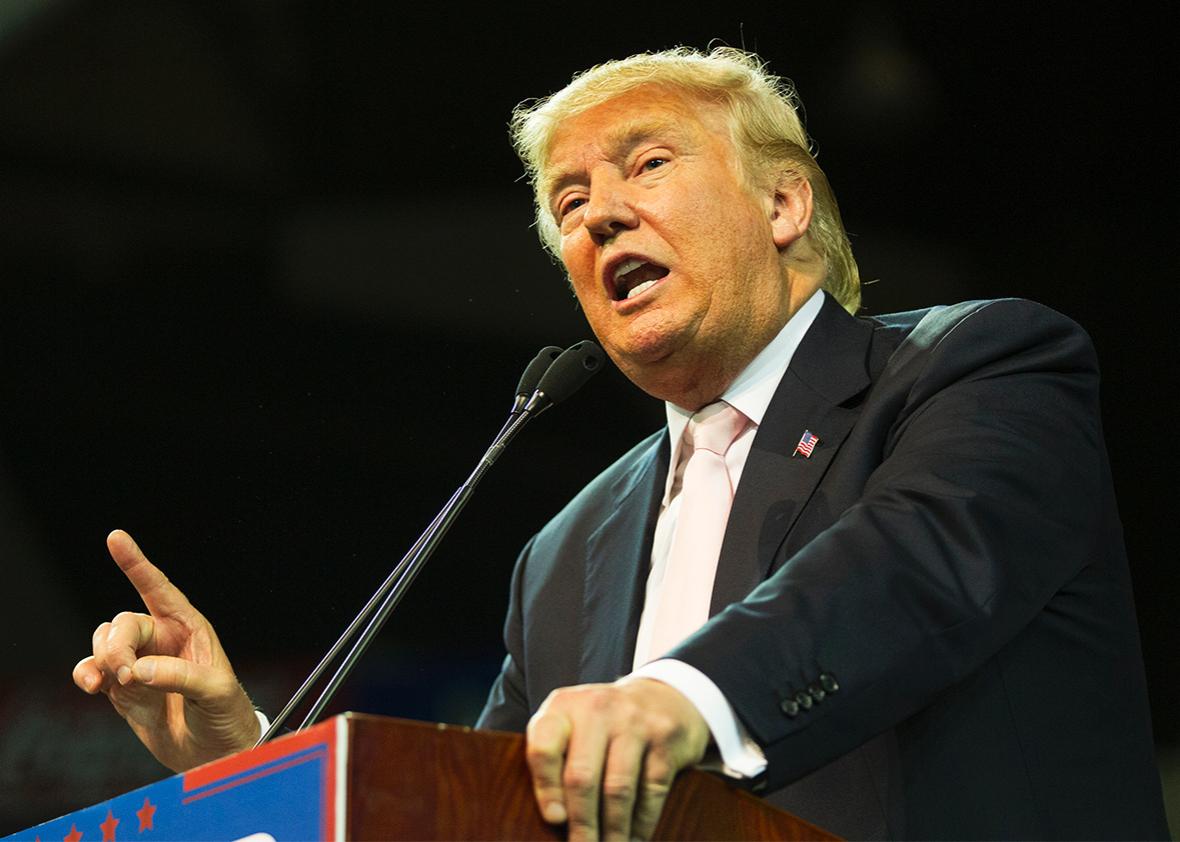Donald Trump has formidably strong support among working-class voters, who showed up for him in a big way on Super Tuesday. He’s cultivated that following by making grandiose promises not just about isolationism but also about the economy. Trump’s mantra about making America great again is, in large part, centered on economic growth, and specifically on jobs.
Of the policy positions he spells out on his website, three of the five are tied to the economy. He wants drastic changes to our trade relations with China, which is part of his promise to restore all the manufacturing jobs lost to other countries. His tax plan will “create jobs and incentives of all kinds while simultaneously growing the economy.” His theory of immigration reform “puts the needs of working people first.” Beyond the appeals to racism and xenophobia, his message is all about restoring the economic prospects of Americans who have seen them decline.
But if President Trump puts these plans into effect, there is no way they would make jobs great again. Instead, they would most likely throw us into a recession.
How does Trump want to reform relations with China? One big plank is imposing huge tariffs on Chinese exports to the U.S., possibly as large as 45 percent. He would also somehow crack down on China’s lax labor regulations and declare the country a currency manipulator, thereby ensuring more fairness in a global playing field in which Americans have lost too many jobs overseas. “Jobs and factories will stop moving offshore and instead stay here at home,” he assures his followers. “The economy will boom.” One study found that the country lost somewhere around 2 million jobs between 1999 and 2011 to trade competition with China—about 10 percent of all manufacturing job losses during that time. But many of those jobs are likely gone for good and have moved on from China to even lower-wage countries like Vietnam and Indonesia.
What tariffs are certain to do is hurt Americans’ wallets. When Trump says the U.S. loses $58 billion to Mexico in trade, he neglects to mention what we get in return for that money: cheap goods. Tariffs on those products would drive up their prices, forcing Americans who are not seeing much in the way of wage growth to spend more for the same things. There was a natural experiment with just this policy in 2009, when the U.S. levied a 35 percent tariff on Chinese tires. That move saved a maximum of 1,200 jobs while it raised costs for Americans buying those tires by $1.1 billion in one year alone.
Under Trump’s plan, China would also likely retaliate, as it did against the tire tariff with its own on American chicken imports, costing our exporters about $1 billion. That would only hurt American companies, who would likely cut back on jobs.
Next, Trump’s tax plan. The candidate declared that his plan would offer the poor and middle class relief while it went after the “hedge fund guys” by changing the capital gains tax rate on investment income. But the details didn’t bear out his big promises. According to the Tax Policy Center, under Trump’s scheme, the poorest fifth of the country would get less than 1 percent of the benefits of his plan over a decade while the top fifth would get more than two-thirds. Yet it would cost $9.5 trillion in revenue—a far larger bite than under Reagan or even George W. Bush. The conservative-leaning Tax Foundation found that Trump’s claim that the plan will be revenue-neutral not to be true “under any scenario.”
There’s little reason to think that big tax cuts for corporations and the wealthy will lead to a supercharged economy. There’s certainly no evidence that higher rates have a negative impact on economic growth, and in fact, growth has historically been faster under higher top marginal rates. What massive tax cuts for the wealthy do accomplish, on the other hand, is faster growth in income inequality, which hurts economic growth.
Third and last, we turn to Trump’s brand of immigration reform, which wouldn’t help the economy either. Economists have found little negative effect on Americans’ wages from immigration. On the other hand, mass deportation and a blockade against immigrants trying to come into the country could have serious negative consequences, knocking $1.6 trillion off of our gross domestic product. Immigrants are projected to provide nearly all growth in the labor force for the next 40 years, but deporting them would shrink it by 6.4 percent over 20 years.
Of course, it would also cost a lot of money to deport so many people—about $400 billion to $600 billion. Overall, Trump’s prescriptions are pretty pricy: Added altogether, the conservative Committee for a Responsible Federal Budget found that his policies would add between $11.7 trillion and $15.1 trillion to the national debt, including interest payments.
Deficits in and of themselves don’t necessarily harm growth, and can in fact simulate it, particularly when the country is climbing out of a recession. The outcomes depend on how the money is spent; Trump’s plans aren’t likely to involve productive expenditures. And if Trump wants to deliver on his promise to make his plans revenue-neutral, he’ll have to find huge cost savings elsewhere, cutting spending by trillions. Given that he’s said he won’t touch Medicare and Social Security, he would have to slash current spending by more than three-quarters. Those cuts would all but decimate most government programs, including those that spur the economy such as infrastructure projects, job training, and a safety net that boosts economic productivity and mobility, to name only a few.
There’s no telling what a President Trump could actually get passed if he were to enter the White House. But if he got even part of what he wanted, we’d all be in for a very rocky economic ride.
Read more Slate coverage of the 2016 presidential election.
